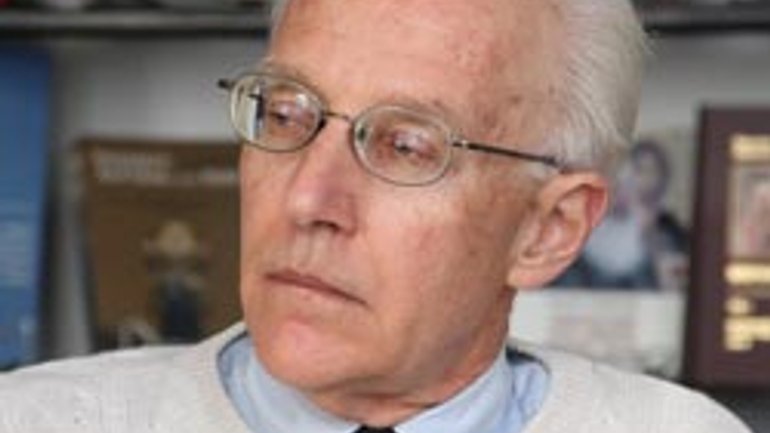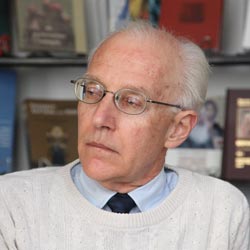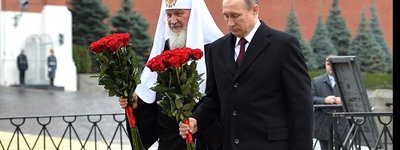Kirill’s Key Man In Kyiv

 As events in Ukraine are spinning out of the regime’s control, and Ukrainians are trying to create a genuine democracy, how will Moscow react? Along with measures in the political and security areas, will it also take steps in the ecclesiastical field? In a recent article in the “Kyiv Post” Daniel Bilak, a Ukrainian-Canadian lawyer who works in Kyiv, links the Moscow Patriarchate’s ambitions to lead the Orthodox world with Russia’s policy of assuming political, economic, and cultural control over Ukraine.
As events in Ukraine are spinning out of the regime’s control, and Ukrainians are trying to create a genuine democracy, how will Moscow react? Along with measures in the political and security areas, will it also take steps in the ecclesiastical field? In a recent article in the “Kyiv Post” Daniel Bilak, a Ukrainian-Canadian lawyer who works in Kyiv, links the Moscow Patriarchate’s ambitions to lead the Orthodox world with Russia’s policy of assuming political, economic, and cultural control over Ukraine.
The author points out that Russia’s bid to lead world Orthodoxy depends on the Patriarchate’s retention of the Ukrainian Orthodox Church. That, he argues, may depend on the succession to the ailing Metropolitan of Kyiv, Volodymyr (Sabodan). Since none of thelikely candidates from Ukraine is entirely acceptable to Moscow, the Moscow Patriarchate, according to Bilak, may appoint the current head of the Russian Church’s Department of External Church Relations to that post.
The Church of Moscow has long seen itself as the leader of Orthodoxy. It saw the attempts of the besieged Patriarchate of Constantinople to conclude a union with the Roman church at the Council of Florence in 1439 in exchange for aid against the Ottoman Turks as evidence of the Greeks’ unreliability. After Constantinople fell to the Turks in 1453, Moscow appeared to be the great hope of the Orthodox faith, and the well-known theory of the Third Rome, launched in the early 1500s, bolstered that claim. The attainment of autocephaly in 1589 strengthened Moscow’s position. The 1596 Union of Brest, in its view, only proved that the Rus’ of Poland-Lithuania were no more dependable than the Greeks. When even the restored Orthodox metropolitanate of Kyiv in the seventeenth century appeared to flirt with Western scholarship and culture, some Muscovite churchmen condemned these concessions to the Latin West. In the twentieth century, when émigré Russian theologians absorbed Western theology, immeasurably enriching their own, more conservative circles in Moscow looked on in dismay. In the late Soviet period, however, it was only dissident Russian Orthodox clergymen like Fr. GlebYakunin who seemed to sympathize with Ukrainian aspirations for independence. Naturally, the overwhelming support that the Ukrainian churches have given to the Maidan demonstrators’ embrace of European values must seem like one more proof that Orthodoxy will deteriorate if Moscow does not maintain its control.After all, Orthodox Ukraine is split into three churches, two of which are “schismatic” and therefore “uncanonical.”
Today, according to Mr. Bilak, the Russian Orthodox Church’s numerical superiority over all other Orthodox churches appears to permit its taking over the leadership from the Ecumenical Patriarchate in Istanbul. But this superiority, he argues, suffers from one serious weakness. Half of its structure is in Ukraine.
This conclusion appears to be based on previous statisticswhich showed that about half of the Moscow Patriarchate’s parishes were situated in Ukraine. In the Soviet period, this included parishes that would later return to the Greek-Catholic Church, as well as those that would leave the Moscow Patriarchate for the independent church of the Kyivan Patriarchate. In the post-Soviet period (2005), J. Buciora found that the Russian Orthodox Church counted over 26,000 parishes on its canonical territory, of which 14,700 (over 50%) were in Ukraine, while only 12,600 were in the Russian Federation. Buciora concluded that if the Moscow Patriarchate were to lose its Ukrainian parishes, it would be smaller than the Orthodox Church in Rumania.
The Russian church’s own statistics, however, cast doubt on this view. In 2008, Metropolitan Iuvenalii reported that his church had a total of 29,628 parishes in 157 eparchies. Two years earlier, the Ukrainian Orthodox Church (Moscow Patriarchate) counted 10,875 parishes in 42 eparchies. Thus, it would appear that in terms of church structure, the Ukrainian portion of the Moscow Patriarchate’s jurisdiction is around one-third.
In terms of the number of believers, Ukraine seems to represent an even smaller proportion. Even if one counts all probable Orthodox believers in Ukraine, regardless of what church (if any) they belong to, the number would not be likely to exceed 30 million out of a total population of 45 million. According to the U.S. State Department’s International Religious Freedom Report for 2011, a national opinion poll by the Democratic Initiatives Foundation and Ukraine Sociology Service found that 26 percent of the population – about 12 million — identifies with the Ukrainian Orthodox Church of the Moscow Patriarchate. Another 31 percent identifies with the UOC-KP, and 2 percent with the Ukrainian Autocephalous Orthodox Church. Thus, the total Orthodox population of Ukraine would come to 58%, or 26 million believers. In Russia, according to the US IRFR for 2011, out of a population of 138 million some 100 million identify themselves as Orthodox (though only 5 percent of the population – some 7 million people --describe themselves as observant). The Ukrainian Orthodox would thus constitute a little over a quarter of the Orthodox believers in Russia and Ukraine together — and if one counts only those who identify with the Moscow Patriarchate, just 12 percent. Moreover, these estimates ignore the Orthodox population of Belarus, the Baltics, and Kazakhstan. In 2010, the Russian Orthodox Church claimed a total of some 150 million believers worldwide. The Ukrainian portion, including all three Ukrainian Orthodox Churches, would thus be between one-sixth and one-fifth. The UOC-MP alone would constitute only about one-twelfth.
Nonetheless, Ukraine remains important for the Moscow Patriarchate. After all, it regards Kyiv as the “cradle of Russian Christianity.” Kyivan Rus’ is the historic precedent for the “Russian world” that both President Putin and Patriarch Kirill (Gundyaev) are seeking to build. And Ukraine has some of the most important churches and monasteries: Holy Wisdom Cathedral (St. Sophia)in Kyiv, the Pochaiv Monastery, and Kyiv’s ancient Caves Monastery. Thus, the Moscow Patriarchate can no more afford to “lose” Ukraine than can the Kremlin.
Is it likely, then, that in the event of the retirement or demise of Metropolitan Volodymyr of Kyiv, the Moscow Patriarchate would, as Bilak suggests, nominate Metropolitan Hilarion (Alfeyev) of Volokolamsk to the Kyivan metropolitan see?
As chairman of the Patriarchate’s Department of External Church Relations since 2009, Hilarion is an important figure in Moscow’s foreign policy. Born in Moscow in 1966, he was tonsured a monk and ordained in 1987. He holds a doctorate from Oxford University, where he studied under Bishop Kallistos (Ware). Hilarion is also a noted musician and composer of oratorios. Consecrated a bishop at the age of 35, he served in Brussels and Vienna. In 2009 he was appointed Bishop of Volokolamsk, becoming Metropolitan in February of the following year.
Would the Metropolitanate of Kyiv in the Ukrainian Orthodox Church be a logical next step for the 47-year-old hierarch? There is not much precedent to go on. Since the restoration of the Moscow Patriarchate in 1943, there have only been four metropolitans of Kyiv. The first two were in their sixties when they ascended to the Kyivan see and the present incumbent, Volodymyr (Sabodan), was 57 years old.Filaret (Denysenko) was only 37, though he already had considerable experience, having served abroad at Alexandria and Vienna. At the Council of 1990 he came close to being elected Patriarch of Moscow and All Rus’. Thus, it seems that the Kyiv Metropolitanate would be an appropriate posting for a successful, experienced hierarch with patriarchal ambitions.
Would Moscow appoint a Russian to the most important Ukrainian see? Nearly all of the nineteenth- and pre-revolutionary twentieth-century metropolitans of Kyiv were ethnic Russians. The first two metropolitans after the restoration of the Patriarchate in 1943 – Ioann (Sokolov), who served from 1944 to 1964, and Ioasaf (Leliukhin), who served from 1964 to 1966 -- were also Russians. Filaret, who assumed the Kyivan see in 1966, was the first Ukrainian to do so in over 150 years. Premier Nikita Khrushchev’s anti-religious campaign (1959-1964) was over, and the premier himself had been replaced by Leonid Brezhnev and Anatolii Kosygin. A relative liberalization was taking place in Ukraine. When Filaret left the Moscow Patriarchate to help re-establish an independent Ukrainian Orthodox Church in 1991-1992, a synod at Kharkiv elected another ethnic Ukrainian, Volodymyr (Sabodan) in his place. At that point it seemed expedient to emphasize the Ukrainian character of the Kyivanmetropolitanate; from 1990, indeed, the term “Ukrainian Orthodox Church” has been used.
Today, the choice would similarly be affected by Kremlin policy. With great difficulty, Metropolitan Volodymyr has balanced the pro-Russian and the pro-Ukrainian tendencies among his bishops. Depending on the situation, his successor might be a loyal lieutenant of Patriarch Kirill, as Bilak predicts — or a visionary churchman who would unite Ukrainian Orthodoxy; restore proper relations with Constantinople, Moscow, and Rome; and restore the Kyivan church to her proper place in the Orthodox world.










